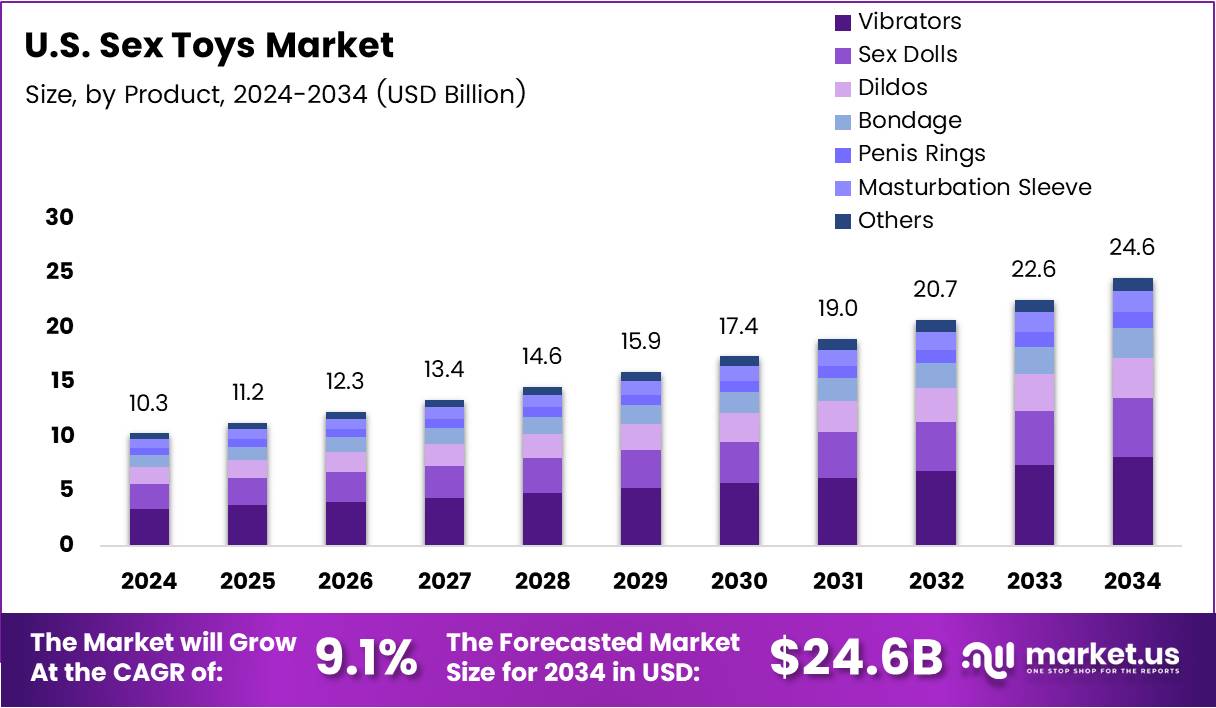Table of Contents
Introduction
The U.S. Sex Toys Market is undergoing a notable shift as sexual wellness gains widespread acceptance and mainstream visibility. The market is expected to reach USD 24.6 Billion by 2034, rising from USD 10.3 Billion in 2024, growing at a CAGR of 9.1% during 2025–2034. This growth reflects changing cultural attitudes, increased awareness, and stronger consumer demand for wellness-centric products.
Digital retail expansion and evolving consumer openness toward sexual health discussions have supported product accessibility. Brands are emphasizing body-safe materials, inclusive product lines, and smart technology features to meet lifestyle preferences. As wellness platforms and social media normalize conversations around pleasure and intimacy, the market continues to evolve dynamically.
Additionally, the influence of health-conscious buyers and gender-inclusive marketing is driving product adoption across demographic groups. With technological advancements and new forms of customization, manufacturers are creating diverse opportunities for growth. These trends indicate a strong long-term market foundation supported by innovation, inclusivity, and consumer confidence.

Key Takeaways
- The US Sex Toys Market is projected to reach USD 24.6 Billion by 2034, from USD 10.3 Billion in 2024, growing at a CAGR of 9.1% during 2025–2034.
- Vibrators dominated the market with a 32.8% share in 2024, driven by innovation and broad online availability.
- Female end-users accounted for the largest market share of 58.3% in 2024, supported by growing awareness of sexual wellness.
- E-commerce channels led distribution with a 57.2% share in 2024 due to convenience and discreet purchasing options.
Market Segmentation Overview
By Product: The vibrators category held a leading share of 32.8% in 2024, benefiting from diverse design innovation and discreet online purchasing. Other segments, including dildos, sex dolls, and masturbation sleeves, continue to expand as consumer preferences diversify and material quality improves.
By End-user: Female users accounted for 58.3% of the market due to increasing sexual wellness awareness. Meanwhile, male and LGBTQ+ users continue to drive demand for inclusive and ergonomically designed products tailored to specific comfort and experience needs.
By Distribution Channel: E-commerce dominated with 57.2% share due to privacy, customer reviews, and broad product variety. Specialty stores remain essential for providing educational support and in-person consultations, while mass merchandisers are gradually increasing selective placements.
Drivers
Rising Acceptance of Sexual Wellness: Changing cultural norms have normalized discussions around sexual pleasure and personal wellness. As more individuals embrace sexual health as part of holistic well-being, product demand increases across gender and age groups.
Growth in Digital Retail Platforms: Online channels offer privacy, convenience, and access to a wide product selection. Discreet shipping and digital marketing strategies significantly support brand visibility and consumer trust.
Use Cases
Personal Wellness and Stress Relief: Sex toys are increasingly recognized as tools for stress relief and self-care. Users integrate these products into personal wellness routines, contributing to repeat purchase behavior and long-term market stability.
Couple Intimacy and Relationship Enhancement: Many products are designed to support shared intimacy experiences. Couples use devices to improve communication, enhance physical connection, and explore new forms of bonding.
Major Challenges
Regulatory and Retail Barriers: Despite growing acceptance, conservative regulations and social discomfort still limit offline retail expansion. This restricts visibility for some segments and delays broader normalization.
Counterfeit Product Concerns: The presence of low-quality imports undermines consumer trust. Products that fail material safety standards can create negative perceptions and reduce brand credibility.
Business Opportunities
Inclusive and Gender-Neutral Designs: Expanding product lines that address LGBTQ+ and non-binary users presents strong growth potential. Brands adopting universal designs position themselves for broader appeal.
Smart Technology Integration: AI-enabled, app-controlled, and sensory-responsive devices enhance personalization. These innovations are attracting tech-forward consumers and expanding premium market segments.
Regional Analysis
North America: The U.S. remains the leading market due to high consumer awareness, online retail adoption, and inclusive wellness advocacy. Increasing educational content and influencer-driven sex-positive messaging continue to reinforce growth.
Europe and Asia Pacific: Europe demonstrates strong adoption in wellness-focused communities, while Asia Pacific is gradually expanding through urbanization and rising exposure to digital intimacy education. Both regions present strong long-term opportunity trajectories.
Recent Developments
- February 2024: Dame Products acquired Emojibator to expand playful product offerings targeting younger consumers.
- April 2025: Dame Products acquired Chakrubs, strengthening its presence in holistic intimacy and wellness-focused product lines.
- March 2024: Lovense launched the Tenera 2 clitoral suction vibrator with enhanced app-controlled personalization.
- July 2025: Harry Styles’ brand Pleasing entered the sexual wellness segment with a curated intimacy product collection.
Conclusion
The U.S. Sex Toys Market is positioned for sustained long-term growth as sexual wellness becomes a core element of personal and emotional health. Innovation in materials, inclusivity, and digital engagement will continue to shape competitive strategies. Companies prioritizing transparency, safety, and diverse consumer needs stand to benefit most in this expanding and increasingly mainstream market landscape.
Discuss your needs with our analyst
Please share your requirements with more details so our analyst can check if they can solve your problem(s)



